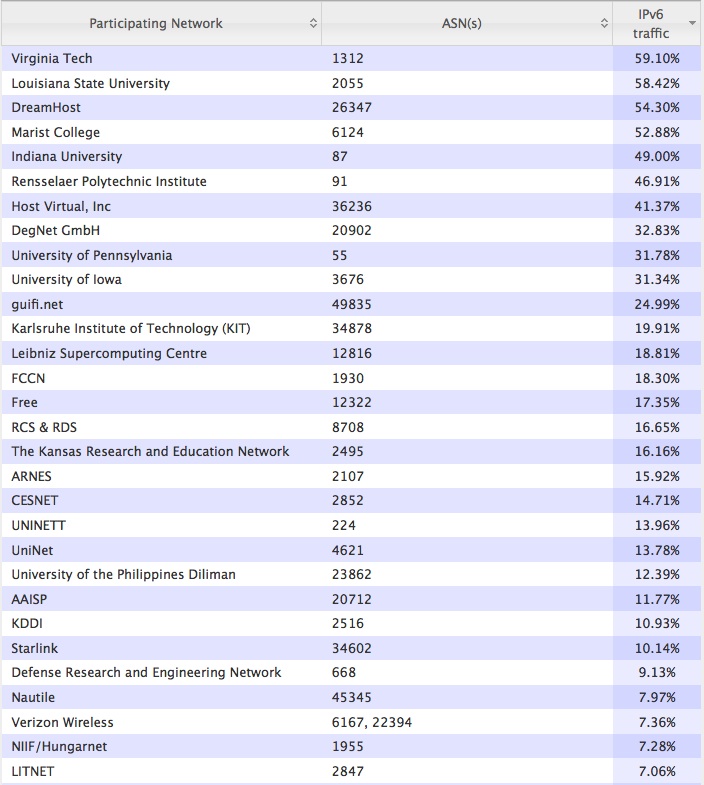A Look at World IPv6 Launch Traffic
The World IPv6 Launch website has compiled a set of measurements at http://www.worldipv6launch.org/measurements/. I’ll take a quick look at some of them here, with a focus on universities.
The “Network Operator measurements” include data collected by Google, Facebook, and Yahoo! for access to their services on June 6th 2012 from the various network operator participants registered for the event. There were only 77 networks in total registered. I’m sure there are a number of other qualified networks that could have provided significant numbers of IPv6 users and traffic. I suspect the initial requirement that network operator participants be able to demonstrate that at least 1% of their traffic constitute IPv6 prior to the event likely dissuaded some potential participants from registering.
Different views of the network operator measurement charts require manipulating javascript controlled knobs at the website, so I can’t provide a direct URL link to them. Instead, in the discussion below, I’m including the relevant screen captures.
View by Total Traffic
The default view presents the participating networks sorted by total volume of IPv6 traffic measured, although the absolute volume number is not disclosed. Several large ISPs lead the list, with Free Telecom (France) occupying the top spot. AT&T (US), KDDI (Japan), RCS & RDS (Romania), Comcast (US), and Verizon Wireless (US) round out the next five. There is a significant disparity in the proportion of IPv6 traffic generated by those networks though, with Comcast seeing only 1.47% and Free seeing 17.35%. I suspect the numbers for Comcast will go up significantly as they turn up IPv6 on more of their home network customers during the coming year (the number was 1.5% on June 6th). The US wireless carriers should also see their numbers go up as more of their users switch to IPv6-enabled 4G/LTE cell phones.
It’s great to see a number of US universities (including my own) feature prominently in the top part of this list also - in ranked order: Indiana University, University of Pennsylvania, Virginia Tech, Louisiana State, and University of Iowa.

View by IPv6 Traffic Percentage
Sorting the table by the “IPv6 traffic percentage” column (the 3rd column below) produces some very impressive looking numbers. In this measure, universities start to dominate the rankings. The top two spots are held by Virginia Tech and Louisiana State, for which close to 60% of traffic constituted IPv6. Other notables include Marist College (53%), Indiana University (49%), RPI (47%), Penn (32%), University of Iowa (31%), Karlsruhe Institute of Technology (20%), & University of Phillipines Diliman (12%). The effect of many of these universities having large parts of their campus networks IPv6 enabled and presumably large numbers of IPv6 enabled computers on those networks undoubtedly had a lot to do with these results.
It would be interesting to see more detailed measurement data from some of these extensively IPv6 enabled campuses about what proportion of their total traffic is IPv6 (as opposed to the subset of traffic only to a set of popular IPv6 enabled services). I hope to be able to share some data from Penn in the near future - we’re currently dealing with some IPv6 traffic accounting bugs with a router vendor first. But our initial calculations are that we were seeing IPv6 account for 8 to 10% of the total traffic traversing the campus border during peak hours of the day. Even though the vast majority of the Internet is not IPv6 enabled, the existence of a number of popular and high-traffic generating services (Google, YouTube!, Netflix, etc) are likely skewing the numbers in favor of IPv6.

Shumon Huque
